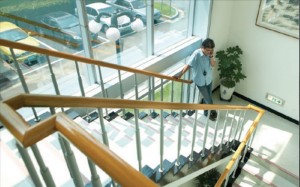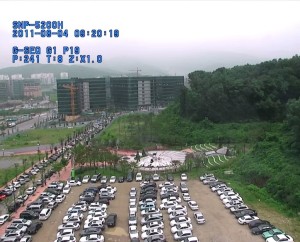Very large facilities, from school campuses and corporate offices to plants and large retail establishments, face a visibility challenge due to their sheer sizes. Staff cannot be everywhere within the facility, making it more likely for intruders to penetrate the perimeter—or for other problems to occur undetected. An increasingly practical and affordable solution is to install networked surveillance systems.
Once a company selects an installation partner, the planning begins. After blueprint review, pre-installation discussions center
around such aspects as which areas need video coverage, inside and out, how many cameras are needed and where they should be placed to achieve the desired coverage.
This may sound like a fairly straightforward process, but it is actually quite complex. On the interior, impediments such as columns, fixtures such as storage shelving, rarely used equipment and even furniture can create line of sight difficulties.
On the exterior, if the location is in a wooded location, or it is in an urban area and is closely spaced with its neighbors, line of sight issues arise. Parking garages with interior access points are also problematic.
 The goal may be to cover as much of the building as possible, or there may be a need to focus on securing strategic ingress and egress points. In some cases, the customer wants continuous coverage, so the collection of cameras can literally follow an intruder or other unauthorized individual on his or her entire trip around or through the building.
The goal may be to cover as much of the building as possible, or there may be a need to focus on securing strategic ingress and egress points. In some cases, the customer wants continuous coverage, so the collection of cameras can literally follow an intruder or other unauthorized individual on his or her entire trip around or through the building.
Design and Selection
During the design process, special attention is placed on areas unlikely to have heavy foot traffic, such as stair towers and garages if they are present. For camera selection, numerous elements, from vandal and weatherproofing to image clarity in dark areas, come into play. Depending on a camera’s location, high resolution imagery with zoom capabilities may also be important.
Continuity of information is also a factor. Engineers consider such issues as whether or not the feed will be monitored, whether and how often it will be archived for later review if needed, and why it might be needed.
If the system will be used primarily for theft prevention and investigation, for example, it might be sufficient for personnel to view footage every day, eliminating the need to retain it for more than a week. If there is a potential for liability that might not be reported right away, such as a customer accident, or if the footprint of the operation makes daily viewing unfeasible, having a longer-range storage option will be preferable.
Final considerations are the video storage and monitoring solutions that will integrate with the cameras. We’ll offer an in-depth discussion of these elements at a later date. For now, we’ll just note that these items also require critical evaluation and careful planning as part of the total solution.
Finding a solution that incorporates feature-rich, affordable cameras paired with appropriate storage and monitoring equipment is not an easy task. Fortunately, LMI has identified several manufacturers with such a broad array of options that every customer’s needs can be met by one of them.
We have recently begun partnering with Samsung, whose Samsung CCTV USA division is garnering both accolades and awards in the industry. We also work with Axis and Sony for video cameras, and we have established relationships with top-rated companies that provide advanced video recording, monitoring and analytics platforms. For more information, please give us a call at (770) 491-0343 or send an email to info@lmisystemsinc.com.
